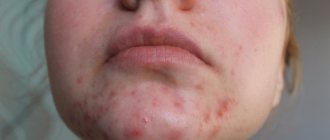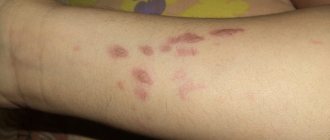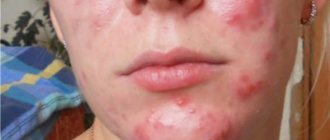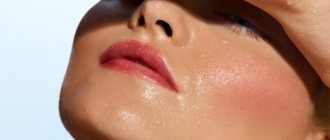- Pearly papules in men
- How common is the problem of penile papules in men?
- Treating pearly papules at home
- Surgical methods for removing pearly papules in men
Pearly papules are small bumps that can form on the ridge of the glans penis. They are a simple anatomical change. At the same time, I should note that penile papules are a natural part of the anatomy of your penis.
You can live with them as they will not bother you and are not associated with any health hazard.
Before diving deeper into the problem, let me reassure you that the appearance of Pearly Papules is completely normal for most men, and a small number of them is a completely normal physical condition.
Also, the disease itself cannot lead to any dangerous consequences, either for sexual life or for a man’s health in general.
Keep reading to learn about the causes, symptoms, diagnosis and proper treatment of pearly papules in men!
Causes
Pearly papules on the glans penis, forming a ring, quite often cause concern in both adolescents and adult men. But there is no need to worry about this, since such formations, according to many dermatologists, are not a disease. The exact cause of a necklace of pearly papules on the glans has not yet been established. There are only a few popular hypotheses for the appearance of white bubbles (sometimes with a violet or purple tint) around the penis and on the coronal sulcus:
- Neoplasms can arise due to blockage of the sebaceous glands. The secretion of sebum increases. The body is unable to cope with such an amount on its own, resulting in papules.
- Hormonal changes in adolescence, during puberty. Androgens increase significantly in quantity, which leads to an excess of smegma. This increases the risk of skin irritation and infection.
- Disruptions in the body's metabolic processes. Too little or too much protein has a detrimental effect on the structure of the skin. If a person consumes few carbohydrates, then the body’s resistance to negative factors decreases.
- Vitamin deficiency can also cause the appearance of bubbles. The lack of tocopherol and retinol has a large impact. These substances are necessary for the proper development of the epithelium, which directly affects the appearance of the skin throughout the body.
- Heredity. In approximately 75% of cases, nodules are inherited from the father or through a generation.
Also, doctors quite often attribute insufficient hygiene to the causes of anomalies. The matter concerns not only the accumulation of smegma, but also waste products. In this case, treatment of papules on the head consists only of correcting the situation.
Removal methods
There is no need to remove the papillary crown, because it is not hazardous to health and does not cause physical discomfort. But many men consider this a defect and want to get rid of it. Some young people even try to do this on their own, which is strictly prohibited.
Self-medication can result in many complications. When plucking with tweezers, tissues are injured. Infection easily penetrates into wounds. Treatment with remedies for papillomas and warts leads to inflammation and swelling. As a result, the head loses sensitivity. Dermatological reactions sometimes occur.
If a man is determined to get rid of white papules on the head, he should resort to one of the following methods used in medical institutions.
Laser coagulation
The most effective and painless method. The tissue of the growths is broken down at the molecular level. Neighboring cells are not damaged. Recovery occurs quickly, no scars remain.
Radio knife
Point exposure to radio waves. As a result of irradiation, free radicals are released that destroy the cells of the papules. Shallow scars may form.
Electrocoagulation
A high-frequency current dries out the growths, after which their remains are removed surgically. Scars often remain after manipulation. The procedure requires anesthesia and subsequent painkillers.
Cryodestruction
Burning with liquid nitrogen. After the procedure, the treated skin turns white, then a painful blister forms in this place. Over time, it is replaced by a crust. Complete healing occurs within 1.5-2 weeks, but a pigment spot may remain. The procedure is dangerous because it affects adjacent tissues and deep layers of skin.
Regardless of the method chosen, you need to be prepared for the fact that hirsutoid papillomas will reappear over time. This is a physiological feature that cannot be eliminated. True, in some cases, circumcision of the foreskin helps solve the problem forever.
Pearly papules on the head are completely harmless. Doctors are inclined to believe that there is no need to remove them even for cosmetic purposes. A mother-of-pearl necklace should not be considered a disadvantage. Small growths are almost invisible, but large ones can be useful. Many women note increased sensations during sex with a partner with this feature due to additional stimulation.
What you need to know about neoplasms
Pearlescent or pearly papules are small whitish (pearly) nodules located under the head of the penis. They form a neat row, sometimes several, located in the area of the coronal sulcus. Outwardly, they are very similar to condylomas - signs of sexual diseases. A venereologist can distinguish these rashes.
They get their name because they look like mother-of-pearl colored pearl shells.
The appearance of these tumors is in no way connected with STDs, and the patient cannot become infected with them or become a carrier. Pearly papules on the head of the penis are not an indication for stopping sexual life. Usually these phenomena do not cause concern, but there are a number of reasons why it is necessary to seek medical help. This should be done in the following cases:
- changes in the size or shape of the papule;
- bleeding of the tumor;
- discharge of liquid of any shade;
- to remove papules.
Changes in neoplasms are possible if a man becomes ill with a sexually transmitted infectious disease, and this requires medical diagnosis and assistance. Doctors' help will be required if a man decides to remove pearlescent papules.
Another type of harmless formation is Freudas granules. These are papules located at the root of the penis or in the scrotum area. They appear in single or group nodules, are light in color and do not harm health. Such granules are ordinary sebaceous glands located close to the upper layers of the epidermis.
According to statistical studies, men with preserved foreskin are more likely to encounter these formations. For those who have been circumcised, the symptoms occur half as often. In dark-skinned people, purple (another name for nodules) papules are also twice as common as in Europeans and Asians.
The main time for the appearance of papules is the period of male reproductive activity, that is, from 20 to 40 years. However, this is not an exact framework, because the appearance of neoplasms was also recorded in puberty boys.
The exact reasons for the appearance of formations are not known to science.
Another statistical fact: almost every second man has this type of education, but most of them are not aware of it. This is explained by the fact that pearly papules are so small that they can be detected with a careful medical examination.
Pearlescent papules are a natural phenomenon and are a variant of normal development. When they are accidentally discovered, the men panic and rush to the clinic.
A visit to the doctor is important to make sure the phenomenon is harmless and to rule out infections. Because pearlescent papules in men are similar to condylomas acuminata.
Before visiting a venereologist, the absence of phenomena characteristic of the presence of pathogenic microflora should calm the panic mood and calm the patient down. Purple papules do not cause:
- itching, burning, peeling of the skin at the site of the rash;
- hardness of the neoplasm;
- a thin stalk on which the bundle rests;
- different sizes of tumors;
- a depression similar to a navel in the center of the papule;
- blood or other liquid when pressed.
If these phenomena do not exist, there are no prerequisites for the occurrence of a sexually transmitted infection (a constant trusted partner, lack of sexual intercourse, etc.), there is no need to worry.
What do harmless nodules look like? These are small formations located under the head of the penis. They all have the same size, whitish or flesh-colored, matte or shiny. They are located tightly to each other, forming a ring (mother-of-pearl crown). Their appearance on the head of the penis is very rare, but is also a normal option.
They do not increase, do not grow, and do not affect the health and life of the patient. Over the years, they become less noticeable, which is explained by age-related pigmentation.
Why do they appear?
Modern means of self-defense are an impressive list of items that differ in their operating principles.
The most popular are those that do not require a license or permission to purchase and use. In the online store Tesakov.com, you can buy self-defense products without a license. The reason for the appearance of pearly papules is not completely clear. There are no particular differences in the frequency of their occurrence among different races or geographic areas. The only point that has been reliably noted is that in circumcised men they are almost half as common.
Pearly papules most often occur in men during their second or third decade of life, with a gradual decrease in frequency with aging.
Features of papules
Often, the onset of the anomaly is observed between the ages of 10 and 13 years. But in some cases, papules can appear after 20-25 years, when a person is sexually active. Gradually the number of pearls becomes smaller, and by about 45 years these new growths completely disappear or become almost invisible.
Cone-shaped and spherical nodules have an average size of 1-5 mm. Mainly spread on the edge of the head of the penis or on the coronal sulcus. Apart from these growths, the anomaly does not manifest itself at all. Unpleasant sensations, swelling, inflammation and bleeding are not observed.
There is no way to get infected with a papule. Nodules cannot be transmitted either sexually or by airborne droplets. A man with this pathology is not contagious. A small part of sexologists are even sure that this framing during sexual intercourse gives a woman even greater pleasure.
The difference between papules and the disease is the uniform distribution of nodules of the same size. The anomaly affects the entire circumference of the penis in one or more rows. That is why such a cosmetic defect is popularly called a necklace.
In some men, similar blisters appear on the scrotum or shaft of the penis. These are Fordyce granules, not pearlescent papules. Such formations occur when the release of fat from the sebaceous glands is disrupted. They also do not cause any discomfort.
When is treatment necessary and what it can be?
Pearlescent small nodules do not pose a threat to human health. Treatment can be carried out at the request of the patient when he is not satisfied with the presence of formations. In women, pearl-colored papules are removed due to a cosmetic defect. In other cases, no treatment is carried out. Elimination methods are similar to those for genital papillomas. Ointments and homeopathy are ineffective in this case.
Operational
Minimally invasive methods used to remove pearlescent nodules:
- laser destruction;
- cryodestruction for papules;
- electrocoagulation.
The laser allows you to effectively get rid of pearlescent growths. The procedure is painless due to the use of local anesthesia. After pre-treatment with antiseptics, an anesthetic is injected into the area of the upcoming operation. A laser is aimed at the formations and burned out due to a sharp increase in temperature in the tissues.
The procedure is bloodless due to the cauterizing effect on the blood vessels. Non-contact removal eliminates the possibility of infection during the procedure.
After removing the papules, a crust forms, which disappears over time. The procedure is carried out quickly. During the recovery period, which takes about 2 weeks, careful care of the wound after pearlescent formation is necessary. Otherwise, complications may arise.
Need advice from an experienced doctor?
Get a doctor's consultation online. Ask your question right now.
Ask a free question
Cryodestruction is a cheap and accessible method. The low temperature created in the papule leads to a narrowing of the vessels that supply nutrition to the formation. This leads to oxygen starvation and cell death. Unlike the laser method, papules do not disappear immediately, but after some time. The rejection of dead nacreous tissue occurs gradually. After several cycles of freezing and thawing, swelling and hyperemia appear. Then a vesicle with serous contents is formed. After this, it passes and a crust forms. It disappears within 1-2 weeks.
The refrigerant is supplied using conductors of different shapes, which ensures local freezing of the pearl-colored area.
Among the disadvantages of the cryodestruction procedure for removing papules is probably incomplete removal or excessive freezing, which subsequently leads to scarring.
Electrocoagulation is the burning of formations using an instrument that is heated to a high temperature using an electric current. The mechanism of action and procedure are similar to laser removal. Cutting off pearly small papules is done using a loop. At the same time, the vessels are cauterized, which prevents bleeding. It is as effective as a laser.
Traditional methods
Before you begin self-medication at home, you need to understand that most traditional methods have not been scientifically tested and have no evidence of their safety and effectiveness. It is recommended to consult with your doctor: dermatovenerologists deal with this problem. The doctor will be able to warn against dangerous treatments.
The most popular methods of treating pearly papules:
- Aloe. It is necessary to cut a leaf of the plant and divide it in half. Then put it in the refrigerator for three days. It is advisable to use plants older than three years of age. Three days later, the leaves are crushed into porridge and poured with cold water in a ratio of 1:5. Let it brew for 1 hour, put it on the stove and bring to a boil. Papules are treated with a cooled solution.
- Mumiyo. One gram of the ingredient is mixed with 50 ml of honey. Place in a water bath, melt and allow to cool. Then add 1 tsp. aloe juice and mix thoroughly. The resulting mixture is applied to pearlescent large and small papules for 10 minutes, then removed and treated with sea buckthorn oil. The course consists of 15 days. Carry out the procedure twice daily.
- Calendula. Dried flowers are poured with boiling water. For 1 tbsp. vegetable raw materials use 500 ml of water. Let it brew for 1-2 hours. The infusion is applied to the affected areas several times a day.
Do not remove papules with iodine, celandine or other aggressive means.
Pathophysiology
Penile papules do not have a malignant potential and are not transmitted to a partner during sexual intercourse. In women, a similar condition may be recorded, which is called “vestibular papillomatosis of the vulva or Hirsuties Papillaris Vulvae,” but this feature is primary, that is, it did not appear as a result of infection from a partner, but existed previously.
According to medical statistics, pearly papules are more common in uncircumcised men. There is evidence that after performing circumcision (excision of the foreskin), the formations undergo regression.
The frequency of occurrence in the human population, according to various sources, is from 8-48%. Pearly penile papules are registered in men after 20-30 years of age; As you age, the manifestations decrease, but remain until the end of life. There are no specific symptoms or signs other than the very fact of presence.
Let us note that patients often come to a urologist after consulting a dermatovenerologist, because they are unable to make a diagnosis on their own and are concerned about a possible venereal disease. Pearly penile papules are also known as hirsutoid papillomas or Hirsuties Coronae Glandis.
On physical examination of the penis, attention is drawn to several rows of small, flesh-colored, smooth, shiny formations located in a circle around the crown or groove of the penis. If the head is covered by the foreskin, inspection is impossible.
How common is the problem of penile papules in men?
Poll: When did your acne appear? (Number of votes: 4295)
I've been suffering all my life
It's been a couple of years now
About a few months
Recently
To vote, click on the desired answer. results
You are not alone! This is a fairly common problem, especially among young men in their twenties and thirties. Papules appear or have appeared at various times in 30 to 48% of all men. It also occurs mainly among a large category of uncircumcised men.
After extensive medical analysis, leading US clinics concluded that papules were found in 33.3% of uncircumcised men and 7.1% of circumcised men.
Before choosing any treatment option for Pearly Papules, you must first diagnose the conditions and causes of the papules as accurately as possible.
The best way to do this is to consult a doctor about your problem and undergo the entire course of treatment under his strict guidance.
Ordinary people often mistake pearly papules for Genital Herpes, which is a significant mistake when treating them independently.
It is quite difficult to identify and distinguish between these two diseases on your own. Therefore, before starting treatment, first make sure that your diagnosis is correct so that you do not apply the correct treatment if the diagnosis is incorrect.
Although the wrong effects of treatment can be easily corrected, it is still for your own good to carry out treatment, no matter how promising, only with the approval of a doctor.
Pearly papules photos in men
Diagnosis of anomaly
Pearly growths on the penis are separated from serious diseases, such as gonorrhea, sarcoma, and genital warts. Without treatment, such pathologies will lead to severe and irreparable consequences. The doctor will be able to determine the nature of the growths during the initial examination. To exclude an erroneous diagnosis, it is usually necessary to conduct some additional studies:
- Microscopy of the contents of the nodule. You need to determine what it is filled with.
- Biopsy of neoplasms. Histological analysis helps to identify the presence of a malignant growth. This procedure also allows you to more accurately prescribe a course of treatment.
- Dermatoscopy. The nature of the origin of the formation is determined.
It is also necessary to take urine and blood tests. In some cases, you need to donate blood for hormones and check the concentration of vitamins in the body. If a serious illness has been detected, then based on the data obtained, a course of therapy is individually selected. It is possible to treat papules , but this is not at all necessary. Pearl necklaces usually appear in men who have not undergone circumcision (circumcision procedure).
Traditional treatment
Pearlescent nodules do not cause any harm to a man’s health, so removal is carried out only for cosmetic purposes. In some cases, hormonal therapy is used in combination with vitamins. All medications are prescribed only by highly specialized specialists. The selection of medication and dosage occurs individually.
The main problem with having nodules is discomfort due to tightness, which can sometimes cause certain difficulties in bed. Psycho-emotional disorders cause sexual dysfunction.
Currently, there are no drugs for treatment (ointments or creams) in pharmacology. But there are many folk recipes that help get rid of papules. Popular substances used in creating remedies for nodules on the head:
- Oil. Both essential and herbal are used.
- Waste products of various animals and insects.
- Medicinal plants.
At present, no one can say for sure that such recipes help. Using traditional methods for treatment is a very long process that requires responsibility.
For example, an ointment made from sea buckthorn oil, honey and mumiyo (everything is mixed in equal proportions) reduces the size of the bubbles, according to those who have tested it. This product must be used for 15 days. The course of treatment is repeated 4 times at certain intervals.
It should be remembered that some substances included in homemade medicines can cause allergies or chemical burns, so it is important to discuss everything with a dermatologist.
Modern help
If you decide to remove the necklace, you should consult a doctor. There are several methods, and each has its own characteristics. The most suitable option is selected only after undergoing a thorough examination. You also first need to exclude possible contraindications to the operation.
For removal use:
- Laser therapy. With this method, anesthesia is not required. Papules or parts thereof are vaporized using a focused beam. On average, the cost of the procedure is 400 rubles per bottle. Contraindication is the presence of oncology.
- A liquid nitrogen. The neoplasm is exposed to extreme cold. This procedure has almost no side effects. The approximate price is 9,000 rubles.
- Electrocoagulation. Using an electrode, each growth is burned out individually. All residual elements (if any) are removed manually. Judging by the reviews, the method is absolutely useless.
Removal using a regular scalpel is also used. This method requires a long rehabilitation period. The entire procedure takes about an hour, and after completion the patient can immediately go home. Recovery occurs in approximately 10-15 days. During this period, you need to regularly treat the surgical area with an antiseptic and maintain sexual rest. As a supplement, vitamin complexes and restorative drugs are prescribed. It should be remembered that the probability of relapse is 65%, and preventive measures have not been established to date.
Pearly papules in women ↑
A similar problem in women is a consequence of damage to the apocrine sweat glands associated with diseases of the genitourinary system. The glands are located in the armpits, pubis, labia majora, and nipples. The cause of the rash has not been established. It is believed that pathologies of the ovaries and thyroid gland contribute to the damage to the sweat glands. Genetic predisposition plays an important role. Papules form in the armpits, genitals, and mammary glands. The rash rarely affects several areas of the skin; the elements look like spherical or conical elevations of small sizes, forming dense clusters. The color is practically the same as the skin color; in rare cases, reddish and purple rashes occur.
During pregnancy, the intensity of symptoms decreases. Hair in the affected area falls out or becomes brittle. The disease is most often diagnosed in women of reproductive age, but rashes may appear during puberty or menopause. Papules are present on the skin for many years and often disappear spontaneously after age 40. Damage to the apocrine glands should be differentiated from neurodermatitis, eczema and herpes zoster.
It is almost impossible for women to get rid of the defect. Retin-A and jojoba oil are used to prevent the spread of rashes. Surgical treatment involves removing elements using electrocoagulation or laser exposure. The procedure is performed under local anesthesia and has a short recovery period. After the procedure, the skin must be treated with special preparations for several days and abstain from sexual intercourse for 2 weeks. In most cases, rashes recur 2-3 years after their removal.
Categorical prohibition
You should not try to remove papules yourself, for example, by squeezing or piercing. Because of this, there is a high probability of infection. The use of antifungal drugs will also not have any effect, but complications may occur.
Removal should only be performed in an operating room by a qualified surgeon. You also need to pay attention to tumors that cause pain. In this case, you should immediately seek help from a specialist. It is necessary to make an accurate diagnosis in time.
There are no preventive measures to prevent the development of vesicular neoplasms on the penis. After all, the appearance of papules is not associated with hygiene standards, sex life or the functioning of the immune system.
Such an anomaly is not a sign of disease or any deviation from the norm. These neoplasms do not cause any harm to the man and can persist throughout his life. If papules cause psychological discomfort, then you can quickly and safely get rid of them.
Our specialists
- Sign up
- Sign up
- Sign up
Reviews
- The plastic surgery of the frenulum was performed by the doctor Mamedov Khalit. Thanks to the doctor and the clinic, everything went quickly and easily. I was preparing for a long time, I was afraid, but it turned out to be 10 minutes and it’s ready, thank you!
NovelApril 12, 2020 at 02:54 pm
- My husband suffered from Peyronie's disease. I had to take him to the doctors in Lazmed. Luckily they were able to help him. Many thanks to the doctors - they are experts in their field, excellent specialists.
Grateful wifeDecember 27, 2020 at 11:55
- Doctors at Lazmed Clinic helped me cure infertility. Thanks to their experience and the right treatment, I will soon become a father. I want to express my gratitude and deep gratitude!
PeterNovember 25, 2020 at 12:10 pm
- For medical reasons, I was prescribed removal of the foreskin. To be honest, I was worried about this operation. But I was reassured by the doctor, who explained how this happens and what to expect after the operation. Everything went perfectly.
VyacheslavDecember 25, 2020 at 11:00
- I would like to say a huge thank you to the urologist at the Lazmed Clinic. With his help and the right approach to treatment, it was possible to avoid complications from prostatitis and become a healthy, full-fledged man. The main thing is not to delay treatment of the disease.
DimaDecember 20, 2020 at 5:37 pm
- At the Lazmed Clinic he treated a well-known male disease - prostatitis. 10 sessions were enough for me to recover and forget about the painful nights with this disease! Laser treatment has proven to be undeniably effective.
AlexeiJanuary 11, 2020 at 01:56 pm
- Having turned to the Lazmed clinic for help in solving a delicate urological problem, I received qualified treatment, and most importantly, I was able to get rid of the disease in the shortest possible time. Many thanks to the doctors!
GennadyJanuary 20, 2020 at 04:22 pm
Small flesh-colored tubercles surrounding the head of the penis are often a reason to consult a urologist. Men consider pearlescent papules a sign of a sexually transmitted disease. Is this true, and in what case is it really necessary to visit a doctor?
Mother-of-pearl papules are nodules that do not have a cavity inside and rise above the surface of the skin. They have a cone shape and a diameter of no more than 3 mm. Their surface is smooth with a shiny tint, which is why they are called pearl.
The papules are absolutely painless to the touch; when pressed, there is no discharge from them. They are located at the base of the head of the penis, as if encircling it with a ring in one or two rows. In some cases, they form on the head itself.
Pearly papules appear in 10–45% of men. This depends on established national and religious traditions - men who have been circumcised have significantly less rashes.
The photo shows pearly papules on the glans penis
Why do they appear?
Doctors can only guess about the causes of the rash. There are several opinions:
- One of them is the increased work of the sebaceous glands and their blockage. Partial confirmation of this version is the rare appearance of papules in men with circumcised foreskin.
- Another theory for the formation of papules in middle-aged men is cell proliferation. Their increased reproduction causes similar harmless proliferation of the epithelium. The appearance of papules is completely unrelated to the orderliness of sexual life or insufficient hygiene.
- In adolescents, pearly papules are associated with hormonal changes and the secretion of smegma - sebum mixed with moisture and dead cells of the surface layer of the skin. It is formed in large quantities during the period of greatest sexual activity.
Rashes of similar localization are possible with primary syphilis, genital warts and molluscum contagiosum. A simple examination is enough for a specialist to distinguish a pearly papule from the manifestations of the mentioned diseases.
Syphilomas (primary syphilitic ulcers) are bright red in color, larger than the papule in size and differ from it in appearance. They have flat edges and a flat bottom, under which the seal can be felt. They are localized not only on the head of the penis, but also on other parts of it.
Genital warts are the result of infection with the papilloma virus. They are distinguished from papules by localization. They are located not only on the head itself and around it, but also at the base of the penis, on the frenulum, next to the anus and on the mucous membrane of the ureter.
You can distinguish a condyloma from a papule by its appearance. It is a skin growth attached to the surface of the skin with a thin stalk.
Molluscum contagiosum also does not have such a clear localization as pearly papules. Ball-shaped formations with a depression in the middle can appear on the genitals, pubic area, buttocks and inner thighs. When pressed, curdled contents appear from the formations.
But this does not mean that you should ignore the symptoms that may appear along with papules:
- itching and burning sensation in the genital area;
- pathological discharge with a foul odor;
- pain in the area where the papules are located;
- problems during sex.
Very rarely, pearly papules on the glans penis can become inflamed. But this happens due to infection when a man tries to get rid of them on his own.
An initial examination may be sufficient to make a diagnosis. Sometimes, to clarify it, a histological examination of the papule is carried out. Distinctive features of the papule:
- dilated thin-walled skin vessels;
- the presence of multinucleated fibroblasts or star-shaped cells;
- increased amount of connective tissue.
We suggest you familiarize yourself with how eczema differs from atopic dermatitis
Pearlescent papules are not transmitted through sexual contact.










